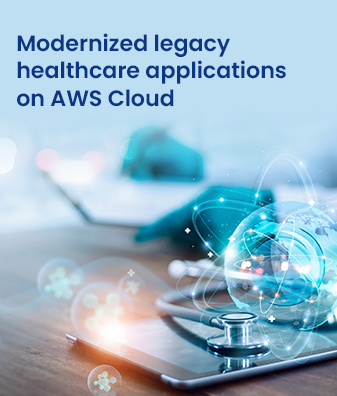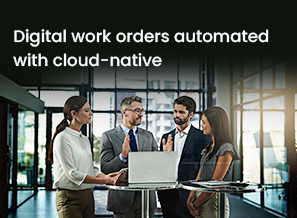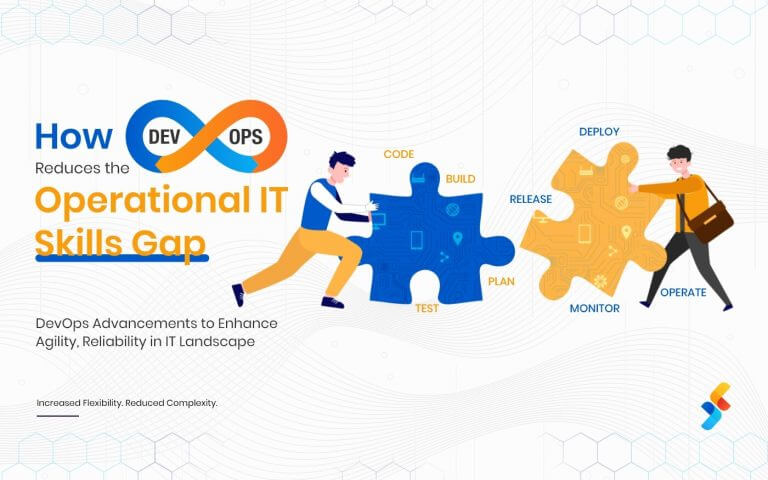A typical digital business operation involves setting up an online store by developing a web or mobile app, and implementing a system or two for designers and developers, utilizing an on-premise network. You put effort into the business marketing, reach a broader audience, and jump on a sale. As your business grows, you thought of scaling it, but your system crashes every now and then, and you begin losing your existing customers and fail to capture new ones.
This was the case a few years ago when top retail stores began to go digital, influenced by increasing adoption of the internet and cloud migrations. Instead of achieving the desired sales, customers, and ROI, they begin to experience a drop in sales, card abandonment, and increasing expenditure costs.
What they needed was a cloud transformation of their business. But what exactly does cloud transformation mean? How does it differ from cloud migration? And more importantly, how can an enterprise implement a cloud transformation strategy that enables it to acquire measurable outcomes? In this blog post, we will explore all these questions and more, offering a clear, strategic, and actionable perspective on cloud transformation.
What is Cloud Transformation?
Cloud transformation is a process of migrating and developing a business’s digital assets, such as infrastructure, data, and applications, from on-premise data centers to cloud-based environments. This business transition is not just technological; it is cultural and operational. Gartner predicts that by 2028, more than 50% of enterprises will utilize industry cloud platforms to accelerate their business initiatives. Unlike cloud migration, which focuses on ‘lift and shift’ or servers or apps, cloud transformation rethinks the enterprise’s architecture, processes, and goals to fully leverage the power of the cloud.
“Cloud transformation is a strategic process through which an organization transitions its digital systems and operations to cloud-based platforms to improve scalability, performance, and innovation capabilities.” The process involves different strategic steps:
- Technology Shift (From monolithic to microservices architecture)
- Operational upgrades (Enabling automation, DevOps practices)
- Workforce and mindset changes (Cloud fluency, agile methods)
Why Cloud Transformation Matters Today?
The pace of business has changed—and so has what it takes to compete with technology-savvy startups. Enterprises aren’t just delivering software anymore; they’re providing services, experiences, insights, and value—all at once, across every digital channel, on every device. What used to be quarterly innovation cycles are now expected on a weekly basis. No one waits for either customers or the market. Since legacy infrastructure wasn’t built for any of this, what companies need today isn’t more hardware—it’s operational agility.
Cloud transformation has emerged as the lever that enables hardware scalability and operational agility. It allows development teams to move with confidence, not caution. To build, release, and refine—without rewriting the whole foundation every time a new demand hits.
Let’s take a look at what exactly is shifting:
- Time-to-market is now measured in hours, not months. Teams need environments that support rapid iteration, not long release pipelines. Cloud-native delivery makes this standard.
- System downtime is proactively addressed or handled in real-time. Whether it’s customer-facing platforms or internal dashboards, reliability is table stakes. Distributed, auto-healing infrastructure deployed on the cloud enables that.
- Security expectations have escalated. With more endpoints, more users, and increased compliance pressure across the geography, governance can’t be reactive. Cloud ensures this with embedded, automated, and policy-driven methods.
- Global delivery is the new norm. Whether you’re scaling to a new geography or responding to sudden traffic spikes, infrastructure must follow demand—not slow it down. Cloud does support the thought.
- Cost discipline is no longer optional. CFOs now look at cloud spend the same way they view any other investment—value must match velocity. That means infrastructure that’s observable, right-sized, and tightly aligned with business outcomes.
Benefits of Cloud Transformation
Cloud transformation unlocks a new way of doing business. When approached with clear requirements and defined objectives, it enables a shift from reactive operations to proactive, intelligent, and scalable delivery. The benefits of cloud transformation extend far beyond infrastructure modernization. They impact product velocity, customer experience, operational resilience, and organizational agility.
Here’s a breakdown of where enterprises see the real value emerge.
Faster Time-to-Market
Speed is a key differentiator in today’s hypercompetitive market. When you build applications on cloud platforms and deploy on cloud resources, you leverage continuous integration, deployment automation, and infrastructure-as-code. This allows teams to ship updates, features, and fixes faster than ever before. This agility enables enterprises to respond to customer demands, market changes, and business opportunities in real-time, rather than within release cycles.
Operational Resilience and Scalability
Cloud-enabled digital transformation empowers businesses to scale intelligently. Cloud platforms like AWS, Azure, Google Cloud, and others have different availability zones spread across locations. Setting up your application’s infrastructure on these platforms allows the applications to responds to demand automatically, be it’s seasonal traffic, a global product launch, or unplanned load spikes.
More importantly, with cloud platforms, resilience is no longer reactive. High availability, auto-healing systems, and global failover architectures become standard, reducing downtime and business disruption with cloud-based application deployments.
Cost Optimization and Spend Alignment
One of the most widely cited benefits of cloud transformation is the ability to align technology costs directly with business usage. Instead of overprovisioning hardware or locking capital into underutilized assets, cloud allows organizations to scale up or down based on real-time usage of resources. There is an advanced level of cost optimization principles that are now practiced as FinOps, with which cloud usage becomes not just cost-efficient, but cost-intentional.
Enhanced Developer Experience
Cloud transformation serves beyond IaaS, PaaS, and SaaS. It simplifies the developer’s workflow. It provides access to self-service platforms, pre-configured environments, and modular infrastructure, enabling engineering teams to focus more on building value and spending less time on managing complexity. This ensures increased productivity, higher job satisfaction, and lower time spent resolving environmental or deployment issues.
Built-in Security and Compliance Readiness
Modern cloud platforms offer deep integration points for security and compliance. From identity and access management to encryption and policy enforcement, organizations can build controls directly into infrastructure and deployment pipelines. This not only reduces risk—it also accelerates audit readiness and ensures compliance becomes a continuous process, not an afterthought.
Foundation for Continuous Innovation
Perhaps the most strategic benefit of cloud digital transformation is the creation of an environment where innovation becomes a systemic process. With modular services, API-first design, and scalable infrastructure in place, businesses can launch new digital products faster, integrate third-party tools seamlessly, experiment without impacting production, and support new technologies as they emerge. Developing applications on the cloud future-proofs the organization’s ability to evolve rapidly.
Difference Between Cloud Transformation and Migration
From the early introduction of cloud computing, organizations have understood it as cloud migration, where they can move their workloads to a cloud platform and pay for the resources they are using. This approach shows the limited capabilities of cloud platforms. Whereas the cloud provides infinite opportunities for businesses. To understand that, its important to know the basic difference between cloud transformation and migration to set a base and better explore how cloud and digital transformation have been happening among businesses.
| Aspect | Cloud Migration | Cloud Transformation |
| Definition | The process of moving applications, data, and workloads to a cloud environment. | A holistic reengineering of systems, processes, and culture to fully leverage the cloud. |
| Scope | Typically, infrastructure- or workload-focused. | Enterprise-wide, affecting people, processes, and platforms. |
| Approach | Often involves “lift-and-shift” methods with minimal code changes. | Involves redesigning apps, rethinking architecture, and enabling agile workflows. |
| Goal | Relocate assets to the cloud for cost or availability benefits. | Drive innovation, scalability, agility, and competitive advantage. |
| Technology Involvement | Basic cloud infrastructure and compute services. | Includes cloud-native tools, microservices, automation, and data platforms. |
| Change Management | Minimal organizational impact. | Significant cultural shift and workforce enablement are required. |
| Time & Effort | Typically faster and less resource-intensive. | Requires longer timelines and cross-functional collaboration. |
| Business Impact | Improves infrastructure efficiency. | Enables digital transformation, better decision-making, and faster innovation. |
| Success Metrics | Uptime, cost reduction, and basic performance improvements. | Business agility, reduced time-to-market, enhanced CX, and competitive growth. |
Key Components of a Cloud Transformation Strategy
To begin your enterprise cloud transformation, you need a strategy in place. A cloud transformation strategy will serve as a roadmap that guides and shapes the digital transformation initiatives based on business priorities, supports evolving operating models, and integrates new technologies or platforms efficiently. Cloud transformation roadmap hence speaks to wider business needs: speed, scale, governance, and future-readiness.
Here’s what that looks like when done right.
1. Strategic Alignment Comes First
A successful cloud transformation strategy doesn’t start with architecture diagrams—it starts with business outcomes.
- Are you trying to reduce time-to-market?
- Enable global product delivery?
- Build internal platforms for scale?
Clarity at this level sets the tone for every decision that follows, from workload prioritization to tooling choices.
2. Current-State Assessment
Before mapping the future, you need an honest picture of today. A cloud transformation roadmap must include a baseline audit of:
- Existing infrastructure and workloads
- Technical debt and monoliths
- Governance and compliance gaps
- Developer experience and delivery bottlenecks
This isn’t just an inventory exercise—it’s a chance to identify where legacy friction is slowing down innovation.
3. Application Modernization as a Core Track
Enterprise cloud transformation is rarely just about moving workloads. It’s about making them work better. This means:
- Refactoring monolithic apps into microservices
- Replatforming critical services to containers or serverless
- Decoupling logic via APIs to enable independent scaling
Modernization ensures that cloud isn’t just a change in hosting—but a shift in how value is delivered to users and customers.
4. Platform Engineering and Internal Enablement
Cloud-native tooling is only half the story. The other half? How teams consume it. A mature cloud transformation roadmap includes platform engineering efforts. It includes standardizing environments, automating provisioning, and reducing toil. This empowers product teams to move fast without compromising on governance or quality.
5. Security, Compliance, and Guardrails
Cloud transformation without governance is just chaos at scale. Security must be baked into the platform, not bolted on after the fact. That means:
- IAM best practices and least-privilege defaults
- Policy-as-code enforcement
- Real-time threat detection integrated into workflows
Especially for regulated industries, automated controls are what make scale sustainable.
6. Observability and FinOps Integration
You can’t optimize what you can’t measure. Your cloud transformation strategy should include:
- Cost visibility at the service and team level
- Usage-based tagging and chargeback mechanisms
- Dashboards that track both technical and business KPIs
Cloud success isn’t just about spend—it’s about spend alignment.
7. Iterative Execution with Measurable Wins
Enterprise cloud transformation roadmap is not a one-year migration plan—it’s an iterative journey. Start small. Prove value. Expand. Measure. This approach de-risks adoption, builds momentum, and creates internal champions across engineering, product, and finance.
Common Cloud Transformation Approaches
An approach to enable cloud transformation for an enterprise depends on its current state of technology, which makes transformation both a challenge and an opportunity. It matters how legacy systems are utilized for day-to-day operations by an enterprise, their regulatory environments, product demands, and organizational readiness. Based on that, the cloud transformation approach is truly defined and documented. Often, different approaches are used to enable the cloud for enterprise digital transformation requirements.
- Lift-and-Shift (Rehosting)
Lift and shift is considered the entry point to cloud transformation as it involves migrating existing applications or workloads to cloud infrastructure without modifying their architecture. The approach is helpful to leverage legacy systems that are operationally stable but require scalability and infrastructure cost reduction. While the lift and ship approach enables rapid migration and supports short-term data center exit strategies, it does not provide cloud-native benefits such as elasticity or automation. The approach is appropriate for use cases where instant transition is required to avoid disruption while planning long-term modernization. - Replatforming
Replatforming involves modernization digital applications to leverage selective managed cloud services like RDS (Relational Database Service), container orchestration (e.g., Amazon ECS or Kubernetes), or autoscaling. It helps reduce operational overhead and improve application performance without rewriting the core codebase. Replatforming is ideal for organizations aiming to balance modernization goals with time-to-market pressures and regulatory compliance. - Refactoring and Re-architecting
Refactoring and re-architecting servers for long-term cloud transformation goals. The process involves reengineering application components to align with cloud-native design patterns—such as microservices, containerization, serverless computing, and event-driven architectures. Legacy applications are refactored into small microservices and then loosely coupled, allowing them to run over containers to provide benefits such as high availability, fault tolerance, and faster release cycles. The approach also optimized the development and deployment of applications by introducing CI/CD pipelines and DevOps practices. Refactoring and re-architecting deliver long-term value by increasing agility and reducing technical debt. This method is often adopted for customer-facing platforms or core systems undergoing digital reinvention. - Hybrid and Multi-Cloud Strategies
Hybrid cloud combines on-premises systems with public or private cloud deployments, while multi-cloud uses services from multiple cloud providers. Most often, enterprises are found to be stuck with hybrid and multi-cloud resources without an impression as how and when to leverage which cloud model effectively and why they have still not achieved promised cloud benefits like reduced cost, etc. Hybrid and multicloud environments also introduce architectural complexity, making it challenging to handle cloud resources effectively. However, a proven cloud transformation strategy can help overcome these challenges by ensuring workload flexibility, risk distribution, and regulatory alignment. - Greenfield Development
Greenfield transformation, as part of a digital transformation initiative, involves developing new applications or platforms entirely on cloud-native foundations from scratch. It is suited for new business models, digital products, or modernization initiatives where legacy systems pose constraints to innovation. Greenfield projects typically leverage containerized microservices, serverless backends, fault-tolerant infrastructure, and platform engineering practices, allowing enterprises to deliver scalable, high-performing digital services with minimal legacy entanglement.
Examples of Successful Cloud Transformation
Let’s understand cloud transformation with two case studies that illustrate how enterprise cloud transformation isn’t theoretical—it’s practical, measurable, and deeply rooted in business value. They show how modern architecture, platform thinking, and user-centered design come together in real-world settings.
Case Study 1: Agritech Mobile Application Modernization
A leading agritech firm sought to modernize its legacy application to better serve its growing user base and ensure high availability during peak farming seasons. Their legacy system, built on a monolithic architecture, struggled with scalability issues, hindering business performance from expanding as intended. Successive Digital led a full-scale cloud transformation initiative with AWS that included re-architecting the application into a microservices-based structure, enabling multi-tenant deployment, and leveraging AWS-native services for scalability and automation. The modernized app not only improved load handling during high-traffic periods but also accelerated feature releases, reduced infrastructure costs, and delivered a consistent, seamless user experience across geographies. As a result, the client achieved faster time-to-market and significantly enhanced user engagement.
Case Study 2: Utility Payment Platform Modernization
A prominent utility service provider was facing challenges with its fragmented, legacy payment systems that led to frequent downtimes and poor user experiences. With a vision to create a unified, scalable, and secure platform, the company partnered with Successive Digital to design and develop an integrated payment solution. The transformation journey involved building a cloud-native platform using modular microservices, real-time APIs, and a centralized billing engine hosted on AWS. The new system enabled seamless payment experiences across mobile, web, and in-person channels while meeting stringent compliance and data security standards. Post-implementation, the provider reported a 60% improvement in payment success rates, a 30% reduction in operational overhead, and a marked increase in customer satisfaction.
Strategic Insights
These two enterprises had very different starting points—but share critical transformation success factors:
- Focused business goals: Modernizing customer interactions, reducing friction, and supporting high-volume transactional engagement
- Cloud-native execution: Containers, serverless, CI/CD, and microservices as enabling technology—not optional afterthoughts come with cloud transformation
- Measurable outcomes: Reduced deployment times, improved stability, improved cost efficiency, and greater user engagement
Future Trends in Cloud Transformation
Now we can state that cloud transformation is no longer viewed as a one-time project. It helps enterprises be ready to adopt, adapt and evolve as markets shift. With rising user expectations and maturing technologies, enterprises must keep pace not just with where cloud is now, but where it’s heading next. Several trends are unfolding and are ready to share the future of enterprise cloud transformation. Let’s check why they matter to organizations that want to stay relevant, agile, and resilient.
1. Platform Engineering Will Reshape DevOps
The next wave of transformation is moving beyond traditional DevOps. Platform engineering is emerging as a structured way to provide internal teams with self-service infrastructure, automated guardrails, and reusable patterns.
Instead of every team building their own pipeline, platform teams deliver paved paths—standardized environments that accelerate development while maintaining governance. This evolution makes cloud transformation sustainable at enterprise scale.
2. Composable Architecture Will Go Mainstream
Monolithic systems are being dismantled in favor of composability—an approach that treats every digital capability as a modular building block. APIs, headless services, and domain-driven microservices are making it easier for teams to adapt, experiment, and pivot quickly.
This shift isn’t just technical. It supports faster go-to-market, easier integration of third-party services, and long-term architectural flexibility.
3. FinOps Will Become a Core Discipline
As cloud spend becomes a line item with board-level visibility, financial operations—FinOps—will evolve from optional governance to essential practice. Real-time usage visibility, showback models, and engineering-aware budgeting will become standard.
In this new environment, cost isn’t just a concern for procurement—it’s a shared responsibility across product, engineering, and finance.
4. Cloud-Native Security Will Be Baked into Delivery
Security is shifting left, but it’s also shifting deeper into the infrastructure. Future-forward organizations are embedding security policies directly into development pipelines, infrastructure code, and container images.
Runtime threat detection, zero trust architecture, and policy-as-code will no longer be advanced practices—they’ll be baseline requirements for operating securely in a distributed environment.
5. Industry-Specific Cloud Services Will Accelerate Adoption
Major cloud providers are doubling down on industry-specific solutions—retail data platforms, healthcare interoperability engines, and financial compliance toolkits. These offerings reduce the burden of customization and accelerate time to value for complex use cases.
As cloud maturity grows, enterprises will gravitate toward verticalized services that solve domain challenges out of the box.
6. Multi-Cloud Strategies Will Mature—Or Consolidate
The multi-cloud debate is shifting from “whether” to “how.” Some enterprises are investing in mature abstraction layers to manage cross-cloud complexity. Others are consolidating to a primary provider for cost, control, or compliance reasons.
Whichever path is taken, the goal remains the same: architecture that supports choice without compromising performance, security, or simplicity.
7. Cloud Governance Will Extend to Sustainability
Cloud transformation is increasingly intersecting with ESG goals. As enterprises strive to measure and reduce their carbon footprint, cloud providers are offering tools for emissions tracking, green compute choices, and region-specific sustainability metrics. Environmental accountability will soon become part of infrastructure governance—not just corporate reporting.
- Operationalizing AI Requires Cloud-First Infrastructure
AI is no longer experimental. Enterprises are already deploying large-scale models in production—powering everything from dynamic pricing and fraud detection to conversational interfaces and real-time personalization.
What separates leaders from laggards isn’t AI adoption—it’s whether the underlying infrastructure can support it.
Cloud-native foundations—elastic compute, scalable storage, container orchestration, and event-driven architectures—are now prerequisites for running and iterating on AI workloads at scale. Without them, enterprises face cost overruns, bottlenecks, and fragmented pipelines.
As more organizations move from AI pilots to full-scale deployments, those without a mature cloud transformation strategy risk falling behind—not in tools, but in outcomes.
Conclusion
Cloud transformation is no longer optional—it’s the operating model of the modern enterprise. From application modernization to infrastructure resilience, its value lies in enabling organizations to move faster, scale smarter, and innovate continuously. But success isn’t defined by technology alone—it’s about aligning architecture with intent, execution with strategy, and delivery with outcomes. As digital experiences evolve and business environments grow more dynamic, enterprises that treat cloud as a core capability—not a tool—will be best positioned to lead. The journey is complex, but when done right, cloud transformation becomes a catalyst for long-term, measurable business growth.












